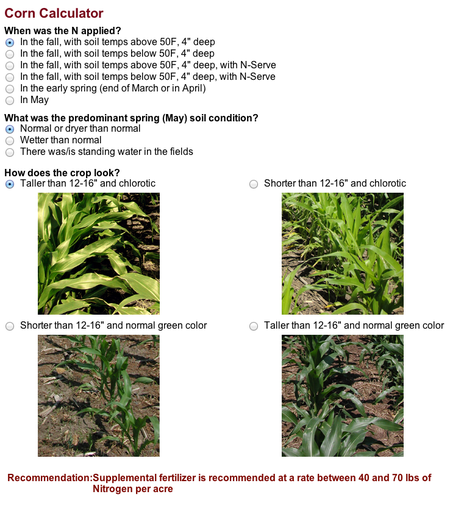June 3, 2014

Spoon-feeding nitrogen makes agronomic and economic sense. These guidelines will help you get the best return on your nitrogen investment.
Sidedress corn at the V5 to V6 corn stage (five or six collared leaves), when the plants are about 20 inches tall, says University of Minnesota Corn Specialist Jeff Coulter.
Heavy spring rainfall does not automatically indicate a heavy nitrogen loss if soils are below 50° F, according to University of Minnesota research.
Skip-row sidedressing works because a relatively small portion of corn roots can absorb all the nutrients, according to the University of Illinois. Because the method supplies nitrogen on one side of each row, injecting nitrogen between every other row maintains yields while reducing power requirements, and increasing maneuverability between rows can cut compaction.
Nitrogen rate
It’s important to calculate how much nitrogen your soil has before applying more. Below are several ways to do this:
One tool is a University of Minnesota in-season corn nitrogen calculator (pdf) can help you determine whether to sidedress nitrogen at corn’s V5 growth stage or beyond.
Another way to determine supplemental nitrogen rates is by calculating the crop’s nitrogen-removal rate comes from Dupont Pioneer: Calculate residual soil-nitrogen levels by multiplying 0.66 (average pounds of nitrogen removed by 1 bushel of corn) by the number of bushels produced per acre. Then subtract that from the amount of nitrogen applied per acre.
A University of Illinois nitrogen-rate calculator is another tool to estimate the amount of residual nitrogen and determine how much you need to adjust for this year’s application.
A spring soil sample is another way to assess the need of the growing crop to calculate an efficient nitrogen application.

Nitrogen form
“Banding with incorporation is obviously the best alternative, but even with 28% or 32% UAN, not all of the N is in a form that is subject to loss,” Kaiser says. “Only half the nitrogen is in the urea form, which is most susceptible to volatilization.”
Since UAN solutions contain about 50% of their N as urea, expect some losses from surface UAN application without incorporation. Agrotain is the only product that’s consistently proven to reduce nitrogen volatilization loss in university tests. There’s not a product that has proven effective to reduce N volatilization from liquid solutions, says the University of Minnesota Extension.
Surface-applied urea fertilizers are at risk for nitrogen volatilization; even more so at higher soil-pH levels. Rainfall of 0.25 in. or more is generally adequate to sufficiently incorporate urea into the soil.
Injecting UAN at least 4 inches deep insures that corn roots will reach the nitrogen and is preferred to broadcast and surface-dribbling UAN solutions, according to the University of Illinois Extension.
Anhydrous ammonia is another preferred nirogen form for sidedressing, says the University of Illinois Extension. The ideal application depth for it hinges on soil type, because its ability to move from application site depends on soil structure. The more clay or organic matter, the more tightly the positive NH4+ ion binds to the negative clay soil ions. Therefore, knife at these depths:
6-8 inches for silt-loams
8-10 inches deep for sandy soils
Sulfur
Sulfur-supplementing decisions can be more challenging, says John Shanahan, DuPont Pioneer agronomy research manager. If you applied sulfur preplant, you may not need to sidedress it except on fields receiving elemental sulfur for the first time this year. Some striping may occur, even when sulfur was applied as elemental sulfur, he says. Sulfur-deficiency symptoms could be caused by rapid plant growth and possible limited sulfur uptake. The corn will grow out of this without affecting yields. If S was not applied this spring, research results indicate that early season applications (V3-V4) of S responded the same as those made at planting.
Surface-applying ammonium thiosulfate between the rows or coulter injected is best, according to University of Minnesota recommendations. Post-application with ammonium sulfate in 2009 and 2010 showed little effect on grain yields at 10 or 20 lbs. sulfur/acre or 42 or 84 lbs. of AMS/acre.
Sulfur can still be applied around the V5 growth stage, according to the University of Minnesota Extension. In most instances, 10 lbs. of sulfur per acre should be adequate for an in-season application. Some leaf burning may occur, but that generally has not been found to reduce yields. Spraying liquid sources containing thiosulfate over the top of growing corn can severely injure corn.
Gypsum (broadcast) is another sulfur source.
About the Author(s)
You May Also Like




